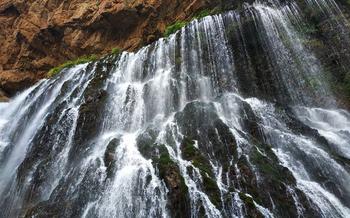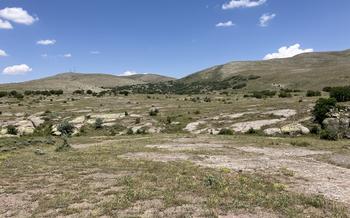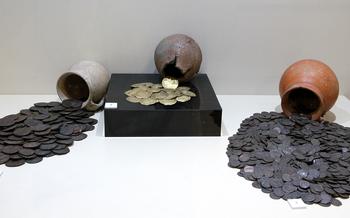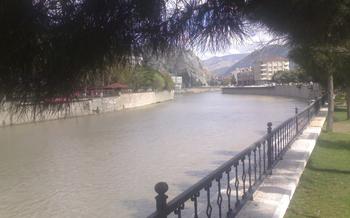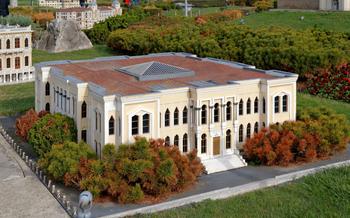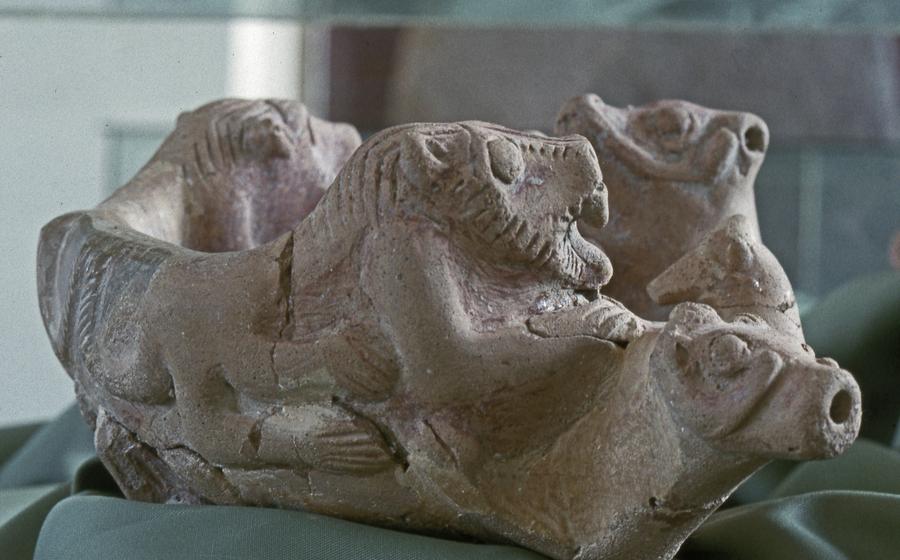
Archaeological Museum Kayseri
- Historical Background: A Journey Through Kayseri's Ancient Heritage
- Location and Accessibility
- Museum Highlights
- Hittite Collection
- Roman and Byzantine Collections
- Seljuk and Ottoman Collections
- Unique Artifacts
- Guided Tours
- Museum Facilities
- Educational Programs
- Accessibility for Visitors
- Hours of Operation and Admission Fees:
- Dress Code and Photography Policy
- Insider Tip:
Historical Background: A Journey Through Kayseri's Ancient Heritage
Kayseri, a city steeped in history, invites you to embark on a captivating journey through time at the Archaeological Museum Kayseri. This remarkable institution houses a treasure-trove of artifacts that tell the story of Kayseri's rich and diverse past, dating back to the dawn of civilization.
The Hittites, an enigmatic empire that ruled over much of Anatolia in the Bronze Age, left an indelible mark on Kayseri's history. Their legacy lives on through the impressive collection of tablets, seals, and sculptures that showcase their advanced civilization.
As centuries passed, Kayseri fell under the influence of the Roman Empire, which brought its architectural prowess and administrative efficiency to the region. The museum's Roman collection boasts exquisite mosaics, coins, and jewelry, offering a glimpse into the grandeur of this era.
The Seljuk and Ottoman empires, with their architectural masterpieces and cultural contributions, further shaped Kayseri's identity. The museum's Seljuk and Ottoman collections feature ceramics, manuscripts, and textiles that reflect the artistic and cultural achievements of these powerful dynasties.
Prepare to be captivated as you wander through the halls of the Archaeological Museum Kayseri, where each artifact whispers tales of a bygone era, inviting you to unravel the mysteries of Kayseri's fascinating past.
Location and Accessibility
The Archaeological Museum Kayseri is conveniently situated in the heart of the city, on Cumhuriyet Meydanı, next to the Kayseri Castle. It can be easily reached on foot from most hotels and attractions in the city center. For those arriving by public transportation, the museum is just a short walk from the Kayseri Otogar (bus station) and the Kayseri Tren Garı (train station).
If you prefer to drive, the museum provides ample parking space for visitors. The museum's strategic location allows visitors to combine their visit with other popular attractions in the area, such as the Kayseri Castle, the Hunat Hatun Complex, and the Sahabiye Medresesi.
Museum Highlights
The Archaeological Museum Kayseri boasts a diverse collection of artifacts that span centuries of history. Among the highlights are the Hittite tablets, which offer a glimpse into the lives and culture of this ancient civilization. These tablets, inscribed with cuneiform script, document everything from religious rituals to economic transactions.
Another must-see is the stunning collection of Roman mosaics. These intricate artworks, depicting scenes from mythology and everyday life, provide a vivid glimpse into the artistic prowess of the Roman Empire. The museum also houses a significant collection of Byzantine icons, renowned for their intricate gold leaf work and religious symbolism.
One of the most captivating artifacts is the statue of Artemis, the Greek goddess of hunting and nature. This well-preserved marble sculpture, dating back to the 2nd century AD, showcases the exceptional craftsmanship of the ancient Greeks. Its serene beauty and intricate details leave visitors in awe.
Hittite Collection
The Archaeological Museum Kayseri houses a remarkable collection of Hittite artifacts, offering visitors a glimpse into the rich history and culture of this ancient civilization. The Hittites, who ruled over much of Anatolia during the Bronze Age, left behind a legacy of impressive architectural structures, sophisticated writing systems, and intricate works of art.
Among the highlights of the Hittite collection are several well-preserved tablets inscribed with cuneiform script, providing valuable insights into the Hittites' language, religion, and laws. These tablets, often adorned with intricate designs and symbols, showcase the advanced level of literacy and record-keeping achieved by the Hittites.
Another notable artifact is a stunning gold seal depicting a Hittite king or deity surrounded by various symbols and figures. This intricately crafted seal, believed to have been used to authenticate documents or mark important objects, exemplifies the Hittites' mastery of metalworking and their attention to detail.
The museum also displays a collection of Hittite sculptures, including stone statues of deities and animals. These sculptures, often carved with great skill and attention to anatomical details, provide a glimpse into the Hittites' religious beliefs and artistic traditions.
Exploring the Hittite collection at the Archaeological Museum Kayseri is a captivating journey through time, allowing visitors to connect with one of the most influential civilizations of the ancient world.
Roman and Byzantine Collections
The Archaeological Museum Kayseri also boasts impressive Roman and Byzantine collections that showcase the influence of these empires on the region. Among the Roman artifacts, visitors can admire intricate mosaics depicting scenes from mythology and daily life. These mosaics provide a glimpse into the artistic prowess and storytelling traditions of the Roman era. The museum also houses a collection of Roman coins, offering insights into the economic and political systems of the time.
The Byzantine collection, on the other hand, features stunning examples of jewelry, pottery, and religious artifacts. Particularly noteworthy are the gold and silver pieces, which showcase the exquisite craftsmanship and artistry of Byzantine artisans. Visitors can also marvel at the well-preserved Byzantine mosaics, which depict religious figures and scenes from the Bible. These artifacts offer a glimpse into the rich cultural and spiritual heritage of the Byzantine Empire.
Seljuk and Ottoman Collections
The Seljuk and Ottoman collections at the Archaeological Museum Kayseri offer a glimpse into the rich history and cultural heritage of these two powerful empires that ruled over Anatolia for centuries. The Seljuks, who established their sultanate in the 11th century, left a lasting impact on the region, as evidenced by the exquisite ceramics, intricate metalwork, and stunning architectural elements displayed in the museum. Visitors can admire the delicate patterns and vibrant colors of Seljuk ceramics, which were renowned for their artistic quality and craftsmanship. The museum also houses a collection of Seljuk coins, providing insights into the economic and political power of the empire.
The Ottoman Empire, which succeeded the Seljuks in the 14th century, brought its own unique contributions to the region. The museum's Ottoman collection showcases a variety of artifacts that reflect the empire's diverse cultural influences. Visitors can marvel at the intricate calligraphy and illumination found in Ottoman manuscripts, which were often used for religious or administrative purposes. The collection also includes textiles, jewelry, and weapons, each representing a different aspect of Ottoman life and culture.
Unique Artifacts
Among the many treasures housed within the Archaeological Museum Kayseri, several unique artifacts stand out, capturing the attention of visitors with their intriguing stories and exceptional craftsmanship. One such artifact is the enigmatic "Smiling Sphinx." Carved from a single block of limestone, this enigmatic sculpture depicts a serene and enigmatic figure with a gentle smile playing on its lips. Its origins remain shrouded in mystery, but its exquisite craftsmanship and captivating expression have earned it a place of honor within the museum's collection.
Another remarkable artifact is the intricately carved "Hittite Lion." This majestic sculpture, crafted from a single block of basalt, showcases the exceptional artistry of the Hittites. With its powerful stance and fierce gaze, the lion exudes an aura of strength and authority. Its discovery in the ancient city of Hattusa, the capital of the Hittite Empire, adds to its historical significance.
The museum also boasts an impressive collection of ancient jewelry, including a stunning "Gold Diadem." This exquisite piece, crafted from pure gold, features intricate filigree work and delicate gemstones. Its discovery in a royal tomb suggests that it once adorned the head of a high-ranking Hittite noblewoman. Its intricate design and exceptional craftsmanship exemplify the opulence and artistry of the Hittite civilization.
Guided Tours
The Archaeological Museum Kayseri offers guided tours in various languages, providing visitors with an immersive and informative experience. These tours are led by knowledgeable and experienced guides who can share in-depth insights into the museum's collection and the history of Kayseri. By joining a guided tour, visitors can gain a deeper understanding of the artifacts on display and their significance in the context of the region's rich cultural heritage.
Whether you are a history buff, an art enthusiast, or simply curious to learn more about Kayseri, a guided tour is an excellent way to enhance your visit to the Archaeological Museum. The guides can tailor their tours to suit different interests and levels of knowledge, ensuring that everyone gets the most out of their experience.
I had the opportunity to take a guided tour of the museum, and I was thoroughly impressed by the expertise and enthusiasm of our guide. She brought the artifacts to life with her captivating storytelling and provided valuable context for understanding the history and culture of Kayseri. I highly recommend taking a guided tour to make the most of your visit to the Archaeological Museum Kayseri.
Museum Facilities
The Archaeological Museum Kayseri offers various facilities to enhance the visitor experience and cater to the needs of different audiences.
-
Gift Shop: The museum has a well-stocked gift shop where visitors can purchase souvenirs, books, postcards, and replicas of artifacts. These items serve as tangible mementos of the visit and contribute to the museum's revenue, supporting its ongoing operations.
-
Cafe: A cozy cafe within the museum provides visitors with a relaxing space to take a break, enjoy refreshments, and discuss their museum experience. The cafe offers a variety of beverages, snacks, and light meals, allowing visitors to recharge and continue their exploration.
-
Library: The museum houses a specialized library that serves as a valuable resource for researchers, scholars, and history enthusiasts. The library contains a collection of books, journals, and documents related to the history, archaeology, and culture of Kayseri and the surrounding region.
Educational Programs
The Archaeological Museum Kayseri also offers a range of educational programs and workshops to engage visitors of all ages and backgrounds. These programs aim to promote cultural heritage, foster creativity, and inspire a lifelong love for learning.
One of the most popular educational programs is the "History Explorers" workshop, designed for children aged 6-Through interactive activities, storytelling, and hands-on experiences, children learn about the ancient civilizations that shaped the region. They get to explore replicas of artifacts, dress up in traditional costumes, and participate in mock archaeological digs.
The museum also offers workshops for adults, such as "Decoding Ancient Scripts" and "Art Appreciation." These workshops delve into the mysteries of ancient writing systems, allowing participants to decipher cuneiform tablets or hieroglyphs. The art appreciation workshops focus on the symbolism and techniques used in ancient artworks, fostering a deeper understanding of the artistic traditions of the past.
By offering these educational programs, the Archaeological Museum Kayseri plays a vital role in preserving and promoting cultural heritage. It creates a welcoming and inclusive environment where visitors can learn, explore, and connect with the rich history of the region.
Accessibility for Visitors
The Archaeological Museum Kayseri is committed to providing an accessible and inclusive environment for all visitors. The museum features a variety of accessibility features to ensure that everyone can enjoy and learn from its rich collection.
Wheelchair ramps and elevators are available throughout the museum, making it easy for visitors with mobility impairments to navigate the different floors and exhibits. Additionally, the museum offers wheelchairs for visitors who need them, available on a first-come, first-served basis.
For visitors with visual impairments, the museum provides large-print labels and audio guides in multiple languages. The audio guides offer detailed descriptions of the artifacts and exhibits, allowing visitors to learn about the museum's collection in a more accessible way.
The museum also offers sign language interpretation services for visitors with hearing impairments. These services can be arranged in advance by contacting the museum directly.
The Archaeological Museum Kayseri is dedicated to creating a welcoming and inclusive environment for all visitors, regardless of their abilities. By providing a range of accessibility features and services, the museum ensures that everyone can experience the wonders of ancient history and culture.
Hours of Operation and Admission Fees:
The Archaeological Museum Kayseri is open to the public from Tuesday to Sunday, with varying hours depending on the season. During the summer months (June to September), the museum is open from 8:30 am to 7:00 pm. In the winter months (October to May), the hours are from 8:30 am to 5:00 pm. The museum is closed on Mondays.
Admission fees are quite reasonable, with a standard ticket costing around 30 Turkish Lira (approximately 5 USD). Discounted tickets are available for students, teachers, and senior citizens upon presentation of a valid ID. Children under the age of 12 are admitted free of charge.
To avoid crowds and enjoy a more relaxed visit, it is advisable to plan your trip during the weekdays, especially outside of the peak tourist season. This will give you ample time to explore the museum's exhibits without feeling rushed.
Dress Code and Photography Policy
Dress Code:
The Archaeological Museum Kayseri adheres to a casual dress code. Visitors are expected to dress respectfully, avoiding clothing that is overly revealing or offensive. Shorts, t-shirts, and comfortable shoes are appropriate attire for exploring the museum.
Photography Policy:
Photography is generally allowed inside the museum, but with certain restrictions. Visitors are permitted to take non-flash photographs of the artifacts and exhibits for personal use only. However, tripods, selfie sticks, and professional photography equipment are not permitted. It is important to be respectful of other visitors and museum staff when taking photographs.
Insider Tip:
To truly immerse yourself in the history and culture of Kayseri, plan your visit to the Archaeological Museum on a weekday morning. This will allow you to avoid the crowds and have a more intimate experience with the exhibits. Take your time to explore each section, read the descriptions, and admire the intricate details of the artifacts. You might even have the chance to engage in meaningful conversations with the museum staff, who are passionate about sharing their knowledge and stories. Embrace the opportunity to learn more about the fascinating past of Kayseri and its significant role in shaping the cultural heritage of Turkey.



